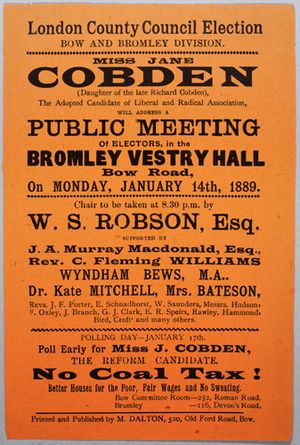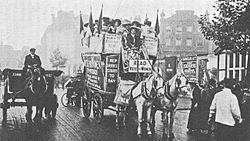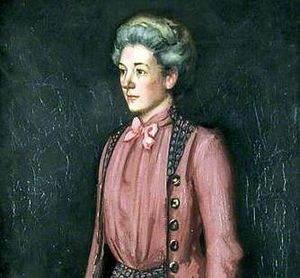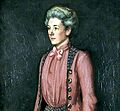Jane Cobden facts for kids
Quick facts for kids
Jane Cobden
|
|
|---|---|
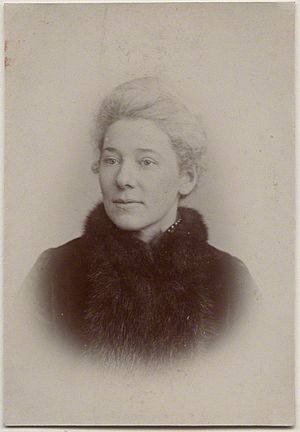 |
|
| Personal details | |
| Born |
Emma Jane Catherine Cobden
28 April 1851 Westbourne Terrace, London, UK |
| Died | 7 July 1947 (aged 96) Fernhurst, Surrey, UK |
| Political party | Liberal |
| Spouse | Thomas Fisher Unwin (m. 1892 – d. 1935) |
Emma Jane Catherine Cobden (born April 28, 1851 – died July 7, 1947), known as Jane Cobden, was a British politician from the Liberal Party. She was very active in many important causes for change.
Jane was the daughter of Richard Cobden, a famous reformer from the Victorian era. She was one of the first people to support women's rights. In 1889, she made history by being one of the first two women elected to the new London County Council. Her election was a big deal, but legal issues made it hard for her to serve fully.
From a young age, Jane and her sisters worked to continue their father's ideas. She always believed in "Cobdenite" causes like land reform, peace, and fairness for everyone. She also strongly supported Irish independence from Britain. Her most important cause was the fight for women's suffrage, which meant giving women the right to vote on the same terms as men. She started working for this cause in 1875. Even though her sister Anne Cobden-Sanderson used more daring methods, Jane always worked within the law. She stayed with the Liberal Party, even when she disagreed with them about women's voting rights.
After marrying publisher Thomas Fisher Unwin in 1892, Jane Cobden started working on international issues. She focused on helping native populations in colonial lands. She was against imperialism and spoke out against the Second Boer War (1899–1902). Later, she criticized the unfair segregation laws in the Union of South Africa. Before World War I, she defended her father's idea of free trade against new taxes on goods. She also helped the Liberal Party bring back the issue of land reform. In the 1920s, she mostly retired from public life. In 1928, she gave her family home, Dunford House, to an association. It became a center for discussing the causes she believed in.
Contents
Early Life and Family
Growing Up with a Purpose
Jane Cobden was born in London on April 28, 1851. Her father, Richard Cobden, was a MP and a leading Radical thinker. He was famous for helping to get rid of the Corn Laws, which were taxes on imported grain. Jane's mother was Catherine Anne. Jane had several siblings: Richard, Kate, Ellen, Anne, and Lucy.
Her father had left his printing business to focus on public service. By 1849, his business was struggling. But public support helped him buy back his childhood home, Dunford House, in Sussex. This large house became Jane's home from 1854. Sadly, her older brother, Dick, died in 1856. This was a very hard time for the family.
Because her father was often away for work, he was not always at home. However, he wrote letters showing his love for his daughters. He wanted them to learn about politics and social issues. Jane and her sisters learned from their parents to care for the poor in their community. Jane's diary from 1864 shows her visiting homes and workhouses. When she was just 12, she and her sister Anne taught classes at the local village school. Their father encouraged them to use their own money to help those in need.
Sisters United for Change
Richard Cobden died in April 1865, just before Jane's 14th birthday. This brought financial worries for the family. But a government pension and a fund from his friends helped them. After their father's death, Jane and Anne went to a school in Maida Hill. However, they left the school after a disagreement.
In 1869, Dunford House was rented out. Jane's mother, Catherine, and her four younger daughters moved to South Kensington. But the sisters, especially Ellen, Jane, and Anne, were very independent. They had different ideas from their mother. So, Catherine moved to Wales with the youngest daughter, Lucy.
In South Kensington, Ellen, Jane, and Anne formed a strong bond. They wanted to keep their father's memory alive and continue his work. They also wanted to fight for his ideas and other important causes. They even stopped the publication of a book about their father that they felt wasn't good enough. Instead, Jane helped arrange for John Morley to write a better biography, which came out in 1881.
During these years, Jane often traveled. In London, she and her sisters met many writers and artists, including William Morris and Edward Burne-Jones. Jane became interested in women's suffrage after attending a meeting in 1871. In 1875, she decided to commit herself to this cause, though she didn't become very active for a few years. In 1879, she helped start the Cobden Club near her father's birthplace.
Early Campaigns for Justice
Fighting for Women's Right to Vote
By the late 1870s, the Cobden sisters began to follow different paths. Anne married in 1882 and became interested in arts and crafts and socialism. Ellen became a writer. Jane became an active member of the Liberal Party, pushing for more radical changes.
Around 1879, Jane joined the National Society for Women's Suffrage. This group was formed in 1867 to fight for women's voting rights. Jane joined their finance committee and later became their treasurer. She spoke at large meetings in London in 1880 and in Bradford in 1881. In 1883, she supported a proposal to give voting rights to women who owned property, just like men.
The National Society was careful and didn't want to get too close to political parties. This led to a split in 1888, and a new group called the "Central National Society" (CNS) was formed. Jane joined the CNS. This new group hoped a future Liberal government would give women the right to vote. However, some members, including Jane Cobden and Emmeline Pankhurst, felt the CNS wasn't doing enough. In 1889, they formed the Women's Franchise League (WFL). This group specifically wanted women to have the same voting rights as men and to be able to hold any public office.
Supporting Ireland's Future
Jane Cobden also strongly supported Ireland. Her father had believed that land ownership was key to solving Ireland's problems. Jane agreed with his ideas on land reform. But she also strongly supported Irish home rule, which meant Ireland governing itself. She gave many talks on this topic and was a big supporter of the Irish National Land League.
After visiting Ireland in 1887, Jane wrote in English newspapers about how badly evicted tenants were treated. She shared the story of the Ryan family in County Tipperary to show the harshness of the British government. Jane sent money and food to help the Ryan family.
Jane was in touch with Irish leaders like John Dillon. She pushed for the release of William O'Brien after he was put in prison. She and her sisters supported the "Plan of Campaign," where Irish tenants worked together to get fair rents from their landlords. This plan was even criticized by the Roman Catholic Church. Jane's support for these rebellious groups in Ireland caused some tension with her father's old Liberal friends. But it earned her praise from Thomas Bayley Potter, who said she understood her father's true feelings better than others.
Making History: London County Council Election 1889
Before 1888, women could vote in some local elections but couldn't serve as councillors. However, a new law in 1888, the Local Government Act 1888, seemed to suggest women could be elected to the new county councils. On November 17, 1888, a group of Liberal women decided to test this. They formed a society to help women get elected and raised money. They chose two women, Jane Cobden and Margaret Sandhurst, to run as Liberal candidates for the new London County Council. Jane ran in Bow and Bromley, and Margaret ran in Brixton.
Even though the Conservatives objected, the women's nominations were accepted. Jane's campaign in Bow and Bromley was very well organized by 29-year-old George Lansbury, who later became a leader of the Labour Party. Both Jane Cobden and Margaret Sandhurst won their elections on January 19, 1889. Another woman, Emma Cons, was also chosen by the council to serve.
The women took their places on the first council and joined different committees. But soon after, Margaret Sandhurst's opponent challenged her election in court. The judges ruled that she was not allowed to serve. Jane Cobden didn't face the same challenge because her opponent was a fellow Liberal who supported her. Still, her position was uncertain. A law said that an election couldn't be challenged after twelve months. So, Jane was advised not to attend meetings until February 1890. After the twelve months passed without a challenge, she went back to her duties.
However, a Conservative member later started new court cases against both Jane Cobden and Emma Cons. He argued that their votes on the council were illegal. The judge ruled against them, but on appeal, the penalties were reduced to a small amount. Jane was urged to refuse to pay and go to prison, but she decided not to. After another attempt in parliament to fix the situation failed, she quietly finished her term on the council without speaking or voting. She did not run for re-election in 1892. Women did not get the right to sit on county councils until 1907.
Historians see this election as an important step for women's rights in Britain. It showed both the challenges and the determination of early feminists.
New Chapters: Marriage and Global Causes
In 1892, at 41, Jane Cobden married Thomas Fisher Unwin. He was a forward-thinking publisher who published works by famous writers like Henrik Ibsen and H. G. Wells. Thomas Unwin's involvement in world and humanitarian causes inspired Jane to expand her interests. She began to focus on international peace, fairness, and the rights of native people in colonial lands. She adopted the name "Cobden Unwin."
Jane and her husband were against the Second Boer War (1899–1902). They helped start the South African Conciliation Committee, which supported the Boers. Jane served as the committee's secretary. The couple lived in South Kensington, where Jane continued her work. In 1893, she represented the Women's Franchise League at a big women's conference in Chicago. At home, she helped women candidates in local elections. In 1900, she became president of the Brighton Women's Liberal Association. That same year, she wrote a strong article called The Recent Development of Violence in our Midst, published by a "Stop-the-War" group.
Edwardian Era: A Dedicated Campaigner
Votes for Women: 1903–1914
Even though Jane Cobden's ideas were more advanced than most of the Liberal Party, she stayed a member. She believed it was the best way to achieve her goals. Other women fighting for suffrage, like her sister Anne, joined socialist groups or used more direct action. When the Women's Social and Political Union (WSPU) started its militant (more aggressive) campaign in 1905, Jane did not take part in illegal actions. However, she supported her sister Anne when Anne was one of the first suffragists sent to prison in 1906.
Jane moved closer to the militant side in 1907 when she supported the WSPU's new magazine, Votes for Women. She also hosted a meeting at her home where WSPU leader Christabel Pankhurst spoke. The WSPU later split, but Jane did not join her sister Anne in the new group. However, she did support the Women's Tax Resistance League, which encouraged women to refuse to pay taxes as a protest.
In 1911, Jane Cobden was in charge of the Indian women's group in the "Women's Coronation Procession" in London. This was a large march organized by suffrage groups from Britain and the Empire. It happened a few days before King George V's coronation. Between 1910 and 1912, several "Conciliation Bills" were discussed in Parliament. These bills aimed to give voting rights to a limited number of women who owned property. When the third bill was being discussed, Jane asked the Irish Parliamentary Party for their help. She reminded them how women had supported Ireland during the Land League protests. But the bill was eventually dropped.
In protest against the Liberal government's policies on suffrage and their harsh treatment of activists, Jane resigned from her honorary presidency of the Women's Liberal Association in Rochdale, which was her father's last constituency.
Social and Humanitarian Work
While women's suffrage was her main focus, Jane Cobden was also active in other campaigns. In 1903, she defended her father's idea of free trade against Joseph Chamberlain's plan for new taxes on goods. Chamberlain wanted to favor trade within the British Empire and tax goods from other countries. Jane spoke in Manchester, saying she was sure the city would remain loyal to "free trade, peace and goodwill among nations."
In 1904, her father's 100th birthday year, she published The Hungry Forties. This book was a very successful and moving piece of writing. It was one of several books and pamphlets about free trade published by her husband's company. These helped make free trade a major progressive cause during the Edwardian era.
The "Cobdenite" idea of land reform became a major Liberal policy again in the 1900s. Jane Cobden's book The Land Hunger: Life under Monopoly, published in 1913, helped this cause. She dedicated the book to her father, hoping his wish for "Free Trade in Land" would come true.
Jane also cared about international issues. From 1906, she was an active member of the Aborigines' Protection Society. This group worked for the rights of native people under colonial rule. In 1907, she spoke to the prime minister, Sir Henry Campbell-Bannerman, on behalf of the Friends of Russian Freedom. She asked for his support for changes to the Hague Convention. She also helped the families of striking workers in London and Dublin during labor unrest in 1913–14. She even helped starving women and children in Tripoli. She also served as secretary for the memorial fund for Emma Cons after Emma's death in 1912.
Later Years and Legacy
During World War I (1914–1918), the women's suffrage movement was less active. Jane Cobden became more involved in South African issues. She supported Solomon Plaatje's fight against the unfair Natives' Land Act of 1913, which separated land for different racial groups. This stance led to her being removed from a committee in 1917. She also continued to support Irish independence and helped victims during the Irish War of Independence (1919–1921).
In 1920, Jane Cobden gave Dunford House to the London School of Economics (LSE). However, she later regretted this gift. In 1923, LSE returned the house to her. In 1928, she donated it to the Cobden Memorial Association. With help from others, the house became a center for conferences and education. It focused on the traditional Cobdenite causes of free trade, peace, and goodwill.
After 1928, Jane Cobden mainly worked on organizing her father's papers. Some of these she placed in the British Museum. She lived quietly at her home near Dunford House. After her husband died in 1935, she rarely appeared in public. Jane Cobden died on July 7, 1947, at the age of 96. Her papers were later collected as part of the family archive. In 1952, Dunford House was given to the YMCA, but it continued its educational mission. The house still holds many items from the Cobden family.
Historians describe Jane Cobden as a strong person. She was known for being very interested in her husband's publishing business. She was a woman who took up causes with great passion. Historian Sarah Richardson notes that Jane's work showed that it was possible to fight for big changes while still being part of the Liberal Party. Jane and her sisters made sure that the Cobden name, known for its progressive ideas, continued to be important well into the 20th century. They proved to be worthy successors to their father, keeping his contributions alive and updating them for a new time.
Images for kids


